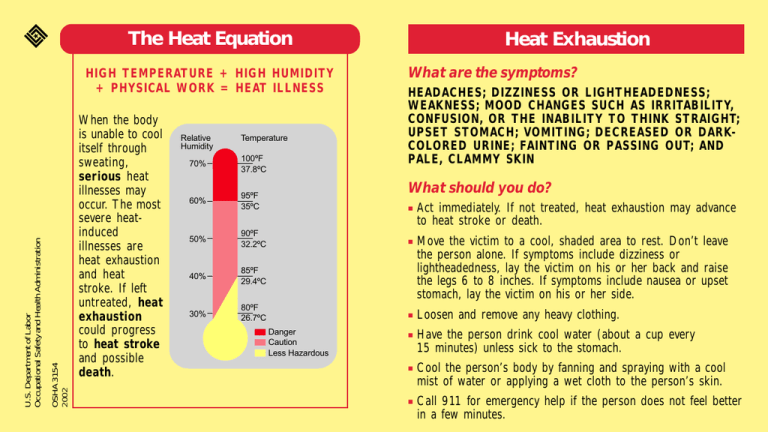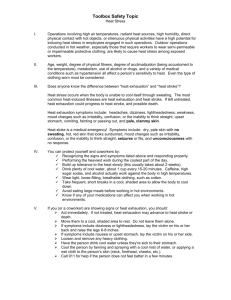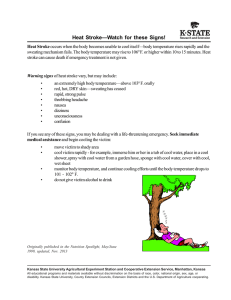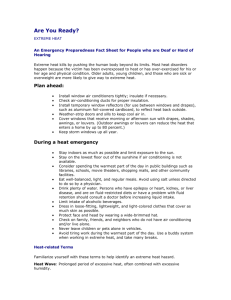Heat Exhaustion & Stroke: OSHA Safety Guide
advertisement

The Heat Equation OSHA 3154 2002 U.S. Department of Labor Occupational Safety and Health Administration HIGH TEMPERATURE + HIGH HUMIDITY + PHYSICAL WORK = HEAT ILLNESS When the body is unable to cool itself through sweating, serious heat illnesses may occur. The most severe heatinduced illnesses are heat exhaustion and heat stroke. If left untreated, heat exhaustion could progress to heat stroke and possible death. Relative Humidity Temperature 70% 100ºF 37.8ºC 60% 95ºF 35ºC 50% 90ºF 32.2ºC 40% 85ºF 29.4ºC 30% 80ºF 26.7ºC Heat Exhaustion What are the symptoms? HEADACHES; DIZZINESS OR LIGHTHEADEDNESS; WEAKNESS; MOOD CHANGES SUCH AS IRRITABILITY, CONFUSION, OR THE INABILITY TO THINK STRAIGHT; UPSET STOMACH; VOMITING; DECREASED OR DARKCOLORED URINE; FAINTING OR PASSING OUT; AND PALE, CLAMMY SKIN What should you do? ■ ■ ■ Danger Caution Less Hazardous ■ ■ ■ Act immediately. If not treated, heat exhaustion may advance to heat stroke or death. Move the victim to a cool, shaded area to rest. Don’t leave the person alone. If symptoms include dizziness or lightheadedness, lay the victim on his or her back and raise the legs 6 to 8 inches. If symptoms include nausea or upset stomach, lay the victim on his or her side. Loosen and remove any heavy clothing. Have the person drink cool water (about a cup every 15 minutes) unless sick to the stomach. Cool the person’s body by fanning and spraying with a cool mist of water or applying a wet cloth to the person’s skin. Call 911 for emergency help if the person does not feel better in a few minutes. Heat Stroke–A Medical Emergency How can you protect yourself and your coworkers? ■ What are the symptoms? DRY, PALE SKIN WITH NO SWEATING; HOT, RED SKIN THAT LOOKS SUNBURNED; MOOD CHANGES SUCH AS IRRITABILITY, CONFUSION, OR THE INABILITY TO THINK STRAIGHT; SEIZURES OR FITS; AND UNCONCIOUSNESS WITH NO RESPONSE What should you do? ■ ■ ■ ■ ■ ■ ■ ■ ■ ■ ■ Call 911 for emergency help immediately. ■ Move the victim to a cool, shaded area. Don’t leave the person alone. Lay the victim on his or her back. Move any nearby objects away from the person if symptoms include seizures or fits. If symptoms include nausea or upset stomach, lay the victim on his or her side. ■ ■ ■ Loosen and remove any heavy clothing. Have the person drink cool water (about a cup every 15 minutes) if alert enough to drink something, unless sick to the stomach. Cool the person’s body by fanning and spraying with a cool mist of water or wiping the victim with a wet cloth or covering him or her with a wet sheet. Place ice packs under the armpits and groin area. Learn the signs and symptoms of heat-induced illnesses and how to respond. Train your workforce about heat-induced illnesses. Perform the heaviest work during the coolest part of the day. Build up tolerance to the heat and the work activity slowly. This usually takes about 2 weeks. Use the buddy system, with people working in pairs. Drink plenty of cool water, about a cup every 15 to 20 minutes. Wear light, loose-fitting, breathable clothing, such as cotton. Take frequent, short breaks in cool, shaded areas to allow the body to cool down. Avoid eating large meals before working in hot environments. Avoid alcohol or beverages with caffeine. These make the body lose water and increase the risk for heat illnesses. What factors put you at increased risk? ■ ■ ■ Taking certain medications. Check with your health-care provider or pharmacist to see if any medicines you are taking affect you when working in hot environments. Having a previous heat-induced illness. Wearing personal protective equipment such as a respirator or protective suit.





